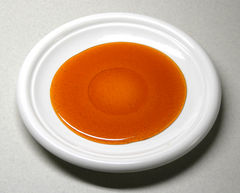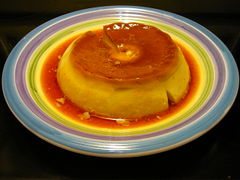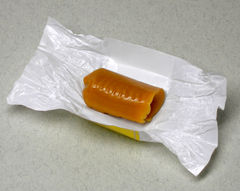Caramel


Caramel (pronounced /ˈkærəmɛl/ or /ˈkɑrməl/) is a beige to dark brown confection made by heating any of a variety of sugars. It is used as a flavoring in puddings and desserts, as a filling in bonbons, and as a topping for ice cream and custard.
The process of caramelization consists of heating sugar slowly to around 170 °C (340 °F). As the sugar heats, the molecules break down and re-form into compounds with a characteristic color and flavor.
A variety of candies, confections, and desserts are made with caramel: caramel apples, pralines, nougats, brittles, crème caramel, and crème brûlée.
Contents |
Etymology
The Arabs invented "caramel", which comes from the Arabic phrase "kurat al milh" كرات الملح and means "ball of sweet salt."[1][2]
Chemistry
Caramelization is the removal of water from a sugar, proceeding to isomerization and polymerization of the sugars into various high-weight compounds. Compounds such as difructose-anhydride may be created from the monosaccharides after water loss. Fragmentation reactions result in low-molecular-weight compounds which may be volatile and may contribute to flavor. Polymerization reactions lead to larger molecular weight compounds, which contribute to the dark brown color.[3]
Caramel candy

Caramel candy is a soft, dense, chewy candy made by boiling a mixture of milk or cream, sugar, butter, vanilla essence, and (more common in commercial production) glucose or corn syrup. It can also be made with chocolate. It is not heated above the firm ball stage (120 °C (250 °F)), so there is almost no caramelization. This type of candy is often called milk caramel.
By extension, a candy may be called a "caramel" if it contains such an ingredient. For example, a chocolate bar with a caramel candy filling may be called a "caramel".
Caramel color
Caramel color (150/E150) is a dark, rather bitter-tasting liquid, the highly concentrated product of near total caramelization that is bottled for commercial and industrial use. Beverages such as cola use caramel coloring, and it is also used as a food coloring.
See also
- Advanced glycation endproducts, physiological effects
- Butterscotch, a type of candy
- Caramel apple, an apple coated in caramel, a taffy apple
- Caramel corn, popcorn coated in caramel
- Caramel sauce, a sauce made with caramel
- Cadbury Dairy Milk Caramel, a British brand of caramel chocolate bar
- Caramac, a British brand of caramel candy bar
- Carambar, a French brand of caramel candy bar
- Caramilk, a Canadian brand of caramel candy bar
- Confection
- Dodol, a caramelized confection made with coconut milk
- Dulce de leche, caramelized, sweetened, condensed milk
- Tablet (confectionery)
- Toffee, a type of candy